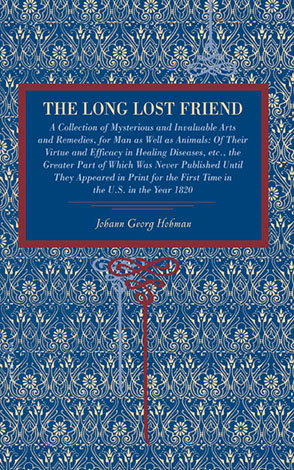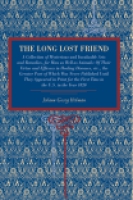
The Long Lost Friend
A Collection of Mysterious and Invaluable Arts and Remedies, for Man as Well as Animals: Of Their Virtue and Efficacy in Healing Diseases, etc., the Greater Part of Which Was Never Published Until They Appeared in Print for the First Time in the U.S. in the Year 1820
Johann Georg Hohman
The Long Lost Friend
A Collection of Mysterious and Invaluable Arts and Remedies, for Man as Well as Animals: Of Their Virtue and Efficacy in Healing Diseases, etc., the Greater Part of Which Was Never Published Until They Appeared in Print for the First Time in the U.S. in the Year 1820
Johann Georg Hohman
Johann Georg Hohman's Long Lost Friend compiled practical uses of mysterious folk magic and rural home remedies rooted in medieval Europe. First published in America in 1820, these methods derive from Christian theology and shamanistic practices often credited to German immigrants. The chapbook exposes the spells, charms, benedictions, incantations, amulets, talismans, palindromes, herbs, elixirs, potions of animal parts, and herbal remedies that might cure all manner of human afflictions, guard against witches and robbers, and protect cattle and crops. Legend has it that simply carrying this book of Christian magic helped to ward off supernatural forces.
- Unlocked
- Description
- Bio
- Subjects

An Open Access edition of The Long Lost Friend is available through PSU Press Unlocked. To access this free electronic edition click here. Print editions are also available.
The treatments featured in the book reflect the transfer of European culture and concerns to pastoral life in early Pennsylvania. What has become known as the art of powwow among Pennsylvania Dutch citizens and scholars is still practiced in some rural areas of the state. The collection is cited widely, from enthusiasts of African-American Hoodoo to theology scholars, and it preserves a fine example of ethnic heritage.
Johann Georg Hohman was a prominent figure in both popular printing and folk magic of the Pennsylvania Dutch community. He immigrated to Reading from Hamburg in 1802 and made a long career of publishing books, ballads, and broadsides. As publisher of some of the first Germanic broadsides and ballads in America, Hohman attempted to improve the translated songs and remedies for ease of singing and recitation. He disappeared after producing his last work in 1846.
Homhan's mysterious European origin, unrecorded death, and Roman Catholic faith—rare in a Protestant society—all add to the intrigue of reading his works. Other books include the Gospel of Nicodemus, an edition of New Testament apocryphal works, and the last before his retreat, The Pious Man's Devotion to God, a reworking of the traditional “The Childhood of Jesus.”
Also of Interest
Mailing List
Subscribe to our mailing list and be notified about new titles, journals and catalogs.




